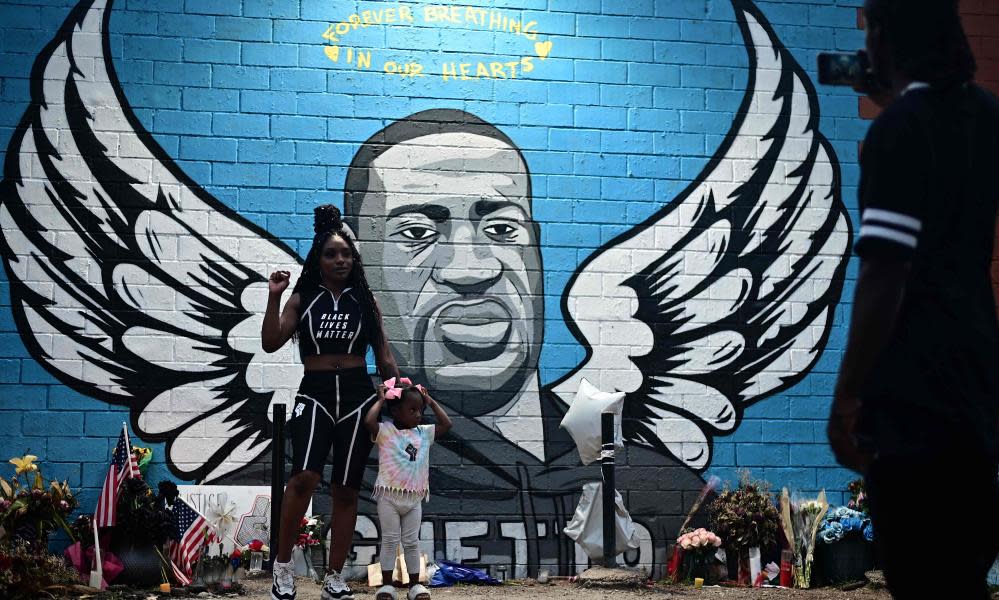His Name is George Floyd by Robert Samuels and Toluse Olorunnipa review – the murder that shamed the US

When George Floyd was in high school, his teacher Bertha Dinkins prophetically told the teen: “I want to read about you in the newspaper… that you have made history and done something to change society”. She could never have foretold that Floyd would become a household name because the world watched a video of police officer Derek Chauvin slowly choke him to death with his knee on his neck in 2020.
The killing sparked the largest protests ever against racial injustice, prompting society to discuss racism in ways it has not done for more than a generation. His Name Is George Floyd (written by two Washington Post reporters) attempts to use the life and death of Floyd as a vehicle to examine the bigotry that lies at the heart of the present-day US.
Figures that spark protests are often barely drawn in two dimensions: we have a name, an image and little else. We know Emmett Till – whose lynching in 1955 is credited with sparking the civil rights movement after his mother displayed his disfigured body in an open casket – as a 14-year-old killed for supposedly whistling at a white woman. Trayvon Martin – whose killing by George Zimmerman in 2012 ignited the Black Lives Matter movement – is the teenager in a hoodie who died for going to a shop to buy Skittles.
The authors make a valiant effort to use Floyd’s story to educate society about the ills of structural racism
In this age of misinformation, where the victims of police killings are made out to be the problem, this humanising of Floyd is necessary. The book does not paint him as a saint but explains his flaws in the context of his experiences. Yes, he was an addict, a convict, and even made a porn movie. But these are not separate from his role as a father, friend and the backbone of his family and community. It is welcome that Floyd is no longer an anonymous Black man and you can feel the devastation of his family, friends and community in the interviews that pepper the book.
Samuels and Olorunnipa’s greatest triumph is placing Floyd’s life in the context of white supremacy. Before we get to Floyd, we learn about his ancestors’ struggles as tenant farmers in the period after slavery was abolished, known as “reconstruction”. Rather than abolition marking an end to racism, we grasp how the logic of racism continued. Racist laws and segregation became the tools for keeping the Black population oppressed. Floyd’s great-grandfather was stripped of the land and money he had managed to accumulate in tobacco farming, leaving the family in the poverty that was passed down through the generations.
The authors reflect on the irony of Floyd being killed after allegedly buying cigarettes with a fake $20 bill, given his family’s history with tobacco. Throughout, Floyd’s life is used to discuss issues such as racial terrorism, housing segregation, mass incarceration and racism in schooling. The point is driven home that his life and death were a result of the racism built into American society. David Smith was killed by Minneapolis police in 2010, in an almost identical manner to Floyd, but there was no public outcry.
There is a way in which all the attention on Floyd’s death has in some way limited the conversation: we all agree that his murder was indefensible, Derek Chauvin went to prison, minimal policing reforms occurred… and now we can move on. His Name Is George Floyd adds to this narrative by focusing on this one event and its aftermath. The lack of any global context severely limits our understanding of racism, which, as Malcolm X explained, is “not just an American problem, but a world problem”.
The focus on Floyd also follows the unfortunate pattern of highlighting the plight of Black men, reinforcing how we are drawn to the spectacle. The violence has tended to be public, from lashings on the plantation to lynchings leaving strange fruit hanging from southern trees. The oppression of Black women is more private – sexual violence, evictions and deadly institutional inequalities, such as being four times more likely to die in childbirth – and more difficult to capture on camera.
Activist and professor Kimberlé Crenshaw started the #SayHerName campaign to draw attention to the Black women who were far more likely to be killed by the police than their white counterparts. I couldn’t read this book without thinking how Breonna Taylor, who was killed in her home by police in 2020, would have been a rich subject.
Related: Fear of Black Consciousness by Lewis Gordon review – why minds, not bodies, are the problem
The horrific murders in Buffalo last weekend are a reminder of how a focus on racism can cloud larger issues. Killing sprees by White supremacist males are a symptom of structural racism but they are so violent and public that they, rather than the ways in which society kills Black people every day, become the basis of our discussions.
In defence of the authors, they make a valiant effort to use Floyd’s story to educate society about the ills of structural racism; for many readers this will be the first time they have encountered the history that shapes the present. But it is also a depressing reminder of how much work needs to be done, of the lessons that still need to be learned this deep into the 21st century.
•Kehinde Andrews is professor of Black studies at Birmingham City University and the author of New Age of Empire: How Racism and Colonialism Still Rule the World
• His Name Is George Floyd by Robert Samuels and Toluse Olorunnipa is published by Transworld (£20). To support the Guardian and Observer order your copy at guardianbookshop.com. Delivery charges may apply

 Yahoo Movies
Yahoo Movies 
